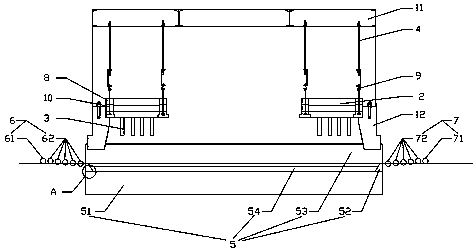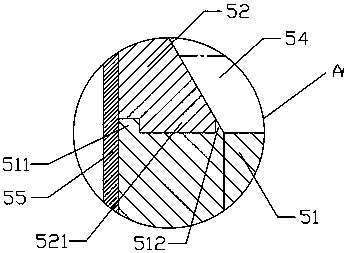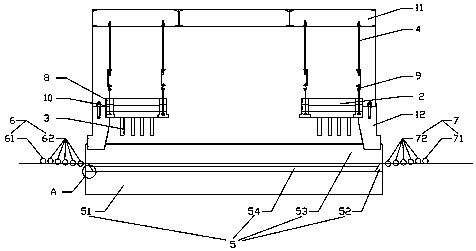Glass ceramic crystallization method and device
A technology of glass-ceramics and crystallization, which is applied in glass forming, glass rolling, glass furnace equipment, etc., can solve the problems of high damage rate of thin plate processing, deformation of plate surface, and limitation of thin plate production, etc., to achieve uniform heating Effects of radiation, improved crack resistance, and enhanced toughness
- Summary
- Abstract
- Description
- Claims
- Application Information
AI Technical Summary
Problems solved by technology
Method used
Image
Examples
Embodiment 1
[0030] Such as figure 1 A crystallization method of glass-ceramics shown, which includes the following steps: Melting: heating the uniformly stirred batch material to 460°C at high temperature, keeping it for 1 hour, then heating to 920°C, keeping it for 1 hour, and finally raising the temperature Melt at 1540°C and keep for 2 hours to obtain molten glass-ceramic liquid. Using a three-step heating method, the temperature rises uniformly, and the heat radiation to the batch material is thorough, which well avoids the appearance of solid impurities in the liquid, and can be obtained Uniform and delicate molten glass greatly improves the quality of the finished glass plate; Calendering: Cool the above glass-ceramic liquid to 1160°C, then send it to the calender for three calendering, and perform one calendering at a temperature of 960°C , second calendering at 860°C, third calendering at 760°C, the glass-ceramic is pressed to a thickness of 4mm, and the three-step calendering met...
Embodiment 2
[0032] Such as figure 1A crystallization method of glass-ceramics shown, which includes the following steps: Melting: heating the uniformly stirred batch material to 480°C at high temperature, keeping it for 1.5 hours, then heating to 950°C, keeping it for 2 hours, and finally raising the temperature Melt at 1590°C and keep for 2 hours to obtain molten glass-ceramic liquid. Using a three-step heating method, the temperature rises evenly, and the heat radiation to the batch material is thorough, which well avoids the appearance of solid impurities in the liquid, and can be obtained Uniform and delicate molten glass will greatly improve the quality of the finished glass plate; Calendering: Cool the above-mentioned glass-ceramic liquid to 1180°C, then send it to the calender for three calendering, and perform one calendering at a temperature of 980°C , second calendering at a temperature of 870°C, and third calendering at a temperature of 770°C. The glass-ceramic is pressed to a ...
Embodiment 3
[0034] Such as figure 1 A crystallization method of glass-ceramics shown, which includes the following steps: Melting: heating the uniformly stirred batch material to 520°C at high temperature, keeping it for 2 hours, then heating to 960°C, keeping it for 1.5 hours, and finally raising the temperature Melt at 1610°C and keep for 3 hours to obtain molten glass-ceramics. Using a three-step heating method, the temperature rises uniformly, and the heat radiation to the batch material is thorough, which well avoids the appearance of solid impurities in the liquid and can be obtained. Uniform and delicate molten glass will greatly improve the quality of the finished glass plate; Calendering: Cool the above glass-ceramic liquid to 1190°C, then send it to the calender for three calendering molding, and perform one calendering at 1040°C , second calendering at 900°C, third calendering at 880°C, the glass-ceramic is pressed to a thickness of 6 mm, and the three-step calendering method m...
PUM
| Property | Measurement | Unit |
|---|---|---|
| thickness | aaaaa | aaaaa |
| height | aaaaa | aaaaa |
| height | aaaaa | aaaaa |
Abstract
Description
Claims
Application Information
 Login to View More
Login to View More - R&D
- Intellectual Property
- Life Sciences
- Materials
- Tech Scout
- Unparalleled Data Quality
- Higher Quality Content
- 60% Fewer Hallucinations
Browse by: Latest US Patents, China's latest patents, Technical Efficacy Thesaurus, Application Domain, Technology Topic, Popular Technical Reports.
© 2025 PatSnap. All rights reserved.Legal|Privacy policy|Modern Slavery Act Transparency Statement|Sitemap|About US| Contact US: help@patsnap.com



